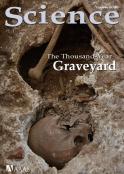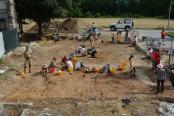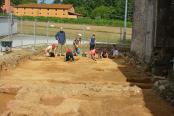CAMPAGNA 2014 |
1° SETTIMANA |
2° SETTIMANA |
3° SETTIMANA |
4° SETTIMANA |
5° SETTIMANA |
6° SETTIMANA |
7° SETTIMANA |
8° SETTIMANA |
23 GIUGNO 2014 
Resoconto della giornata di scavo
Generale
The next field season at Badia Pozzeveri is about to start on June 23, 2014.
The project's goal for the year is to build upon the many important discoveries of the previous seasons by continuing the exploration of the cemeterial and monastic levels of the site. Specifically, we will keep working on the modern cemetery, which revealed the presence of numerous burials dating to the cholera epidemics that afflicted Tuscany in 1855, as well as on the medieval cemetery layers located along the north side of the church and in the churchyard. Further, we will investigate the area in front of the church to expose the foundations of the entire medieval facade by opening a new area (Area 5000) in the churchyard. The location of this new area is particularly interesting because it allows exploring the area between the church and the cloister of the medieval monastery, which likely hosted other cemeterial and architectural features. This, combined with the expansion of other excavation areas centered on the cloister, will enable us to gain more information on the entire sacred complex and the people who lived and died there over the centuries.
Area 2000
La campagna di scavo 2014 nel'area 2000 prevede un'indagine attiva su più fronti utile sia a incrementare le informazioni riguardo l'organizzazione del cimitero Settecentesco ed Ottocentesco, sia a riconoscere e raggiungere le fasi più antiche. E' stato innanzitutto deciso di unire all'Area 2000 la metà subito adiacente dell'Area 1000, posta ad Est, per determinare le relazioni stratigrafiche che le legano o meno e continuare le ricerche iniziate lo scorso anno con l'auspicio di raggiungere i livelli medievali. Nei prossimi giorni sarà inoltre previsto un allargamento verso Ovest; ciò permetterà di ampliare il campione di studio legato alle ultime fasi d'uso del cimitero e, solo ipoteticamente, il campione legato all'evento epidemico del Colera del 1855.
Our unit for the 2014 field season began by cleaning the soil over Area 2000, which is split by the medieval wall into sections A and B, as well as Area 1000. Both areas were previously excavated in past field seasons, and thus our work today consisted of removing the tarps and top layer of dirt and brush, which protected the unit during the offseason. We were attempting to identify color differentiations in the soil in order to determine the locations of features, such as graves, post holes, and trenches, both previously exposed and features to be excavated this field season. In addition, we located 4 probable cuts in the north-west area of section A, as evidenced by the distinct soil compositions. There was also 1 probable cut in north-west area of section B. Some of the cuts have different orientations than previously excavated burials, indicating that the newly discovered cuts may be from different time periods and thus different contexts. The time periods of the burials range between medieval to modern, modern being defined as the 18th to 19th century. Part of Area 1000 was also exposed, in the hopes that the area would contain burials older than those in Area 2000, probably medieval. As we excavate farther down into the unit, we are looking for other cemetery contexts from different time periods. We also hope to extend the unit west, in order to find the limit of the modern cemetery.
Area 3000
É iniziata una nuova campagna di scavo che, per le prossime sei settimane vedrà impegnati gli studenti della Field School di Badia Pozzeveri. La giornata si è aperta con la visita e la presentazione del sito archeologico che, anche quest'anno, sarà suddiviso in quattro aree; in particolare l'area 3000, estesa di fronte alla facciata della chiesa, subirà un ampliamento verso sud, con lo scopo di mettere in luce l'altra metà della facciata, già in parte individuata l'anno scorso, ed il perimetrale meridionale dell'abbazia medievale. Tale struttura muraria, oltre che a delineare l'effettiva estensione dell'edificio religioso, delimiterà anche i confini fra l'area 3000 e l'area 5000, immediatamente adiacente ad essa. Nel corso di questa campagna di scavo le indagini saranno concentrate all'interno dell'antico edificio monastico, ovvero nel Settore B, in modo da approfondire i livelli cimiteriali riferibili ad un orizzonte databile fra il XVIII ed il XV secolo ed individuare le varie fasi di frequentazione dell'abbazia.
We began the morning by extending area 3000 to the south, all the way to the southern perimeter wall and the western end of the original abbey.
From there, we began to clear the rubble, uncovering a disturbed clay layer. In this layer, we found copious amount of bone fragments, in addition to possible funerary goods, such as coins, beads, amulets and a ring.
Outside the original abbey on the southwestern edge, near the door, we uncovered what we believe to be a lithic coffin, which we believe is correspondent to the one found on the past excavation, on the northwestern corner of the original abbey. The lithic tomb may belong to an important member of society since it is located next to the entrance of the original church abbey. This is important because prominent members of society are buried closer to the entrance of the church.
On the southeastern section of the wall, we found a pelvis, a hand, and part of a cranium, which were part of a looser, darker soil that contained little to no clay. On the southwestern section, we found a sandy layer underneath the top soil. In the future excavation, we expect to find more post medieval remains. Underneath the top soil, we hope to find undisturbed graves.
Area 4000
In questa nuova campagna è stato ulteriormente esteso l’orizzonte d’indagine, realizzando un allargamento orientale dell’area di 11,20x8,60 mt. Uno degli obiettivi di quest’anno riguarda l’indagine delle stratigrafie presenti ad ovest della precedente area 4000 settore A (il corridoio orientale del chiostro), per verificare o meno la presenza di ambienti legati al monastero ed afferenti al suddetto chiostro. Un ulteriore punto di approfondimento riguarda le sepolture rinvenute con l’ultima campagna di scavo all’interno del deambulatorio e legate probabilmente a delle inumazioni di monaci legati alla vita abbaziale. L’ipotesi prevede che sullo stesso allineamento di quelle già rinvenute (orientamento nord-sud, una parallela alla struttura orientale del corridoio ovest ed una a quella occidentale) siano presenti altre sepolture di monaci , quindi collocabili cronologicamente in una fase anteriore al XV secolo (periodo che vede la defunzionalizzazione del monastero). Allo stato attuale il nuovo settore dell’area è costituito dal risultato della operazioni di scavo per mezzo meccanico, dunque i prossimi sforzi saranno concentrati sulla individuazione dei primi livelli stratigrafici non intaccati da agenti contemporanei.
Today is the first day of excavation for Field School Pozzeveri of the 2014 season. We began to clean-up on Area 4000, located south of the monastery, and began expanding the area to the west. We also uncovered the 2013 excavations during this process. In the expansion, we uncovered three nails and multiple fragments of pottery ranging from the 16th century to the 20th century. However, most of the pottery was modern while only a few pieces were from before the 19th century. This was due to the use of a backhoe during multiple stages of construction in the area. The pottery and nails were discovered at ground level.
Area 5000
Oggi è cominciata l'apertura dell'area 5000 che si estende di fronte all'attuale facciata della chiesa per un'estensione di 7 m in direzione nord-sud x 10 m in direzione est-ovest. E' stata dunque effettuata la pulizia preliminare dell'area, la quale ha già permesso di osservare la cresta di rasatura del perimetrale sud dell'antica chiesa abbaziale. Questo importante elemento ci fornirà il limite nord dell'area di scavo. Nella porzione ovest, invece, compare uno strato caratterizzato da piccole lastre di ardesia poste orizzontalmente rispetto al terreno. È probabile che queste lastre, usate in antico per la copertura dell'abbazia, siano state riposizionate dopo il loro crollo, livellando quello che allora costituiva il piano di calpestio. Sarà necessario, nei prossimi giorni, continuare con la pulizia dell'intera superficie indagata e con l'eventuale rimozione di strati deposizionali molto recenti, prima di poter pianificare eventuali strategie di scavo.
Today we opened a new area: area 5000. It is located at the west side of the church, exterior to the current facade. It covers an area of 10m east to west, and 7m north to south.
Through the removal of the surface layer, we believe we discovered a piece of the foundation, perhaps the cornerstone. We also found fragments of pottery, metal, and bone. These items were commingled, perhaps due to previous construction and destruction at the site.
Throughout the remainder of this seasons' excavation, we hope to uncover the rest of the wall, as well as skeletal remains and material culture from the Medieval time period.
The overall focus of our work is to determine how the building of the abbey was linked to the ancient church.














